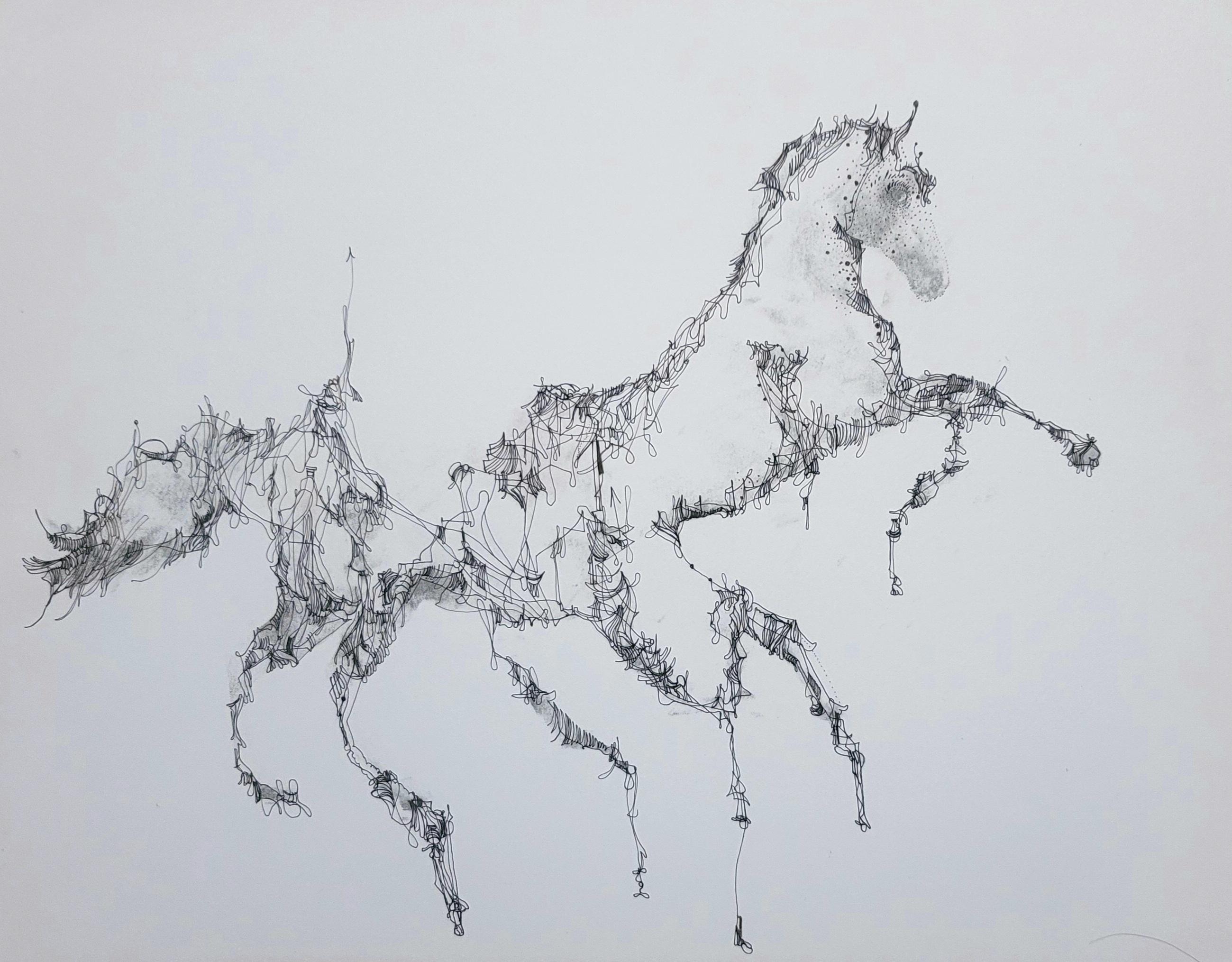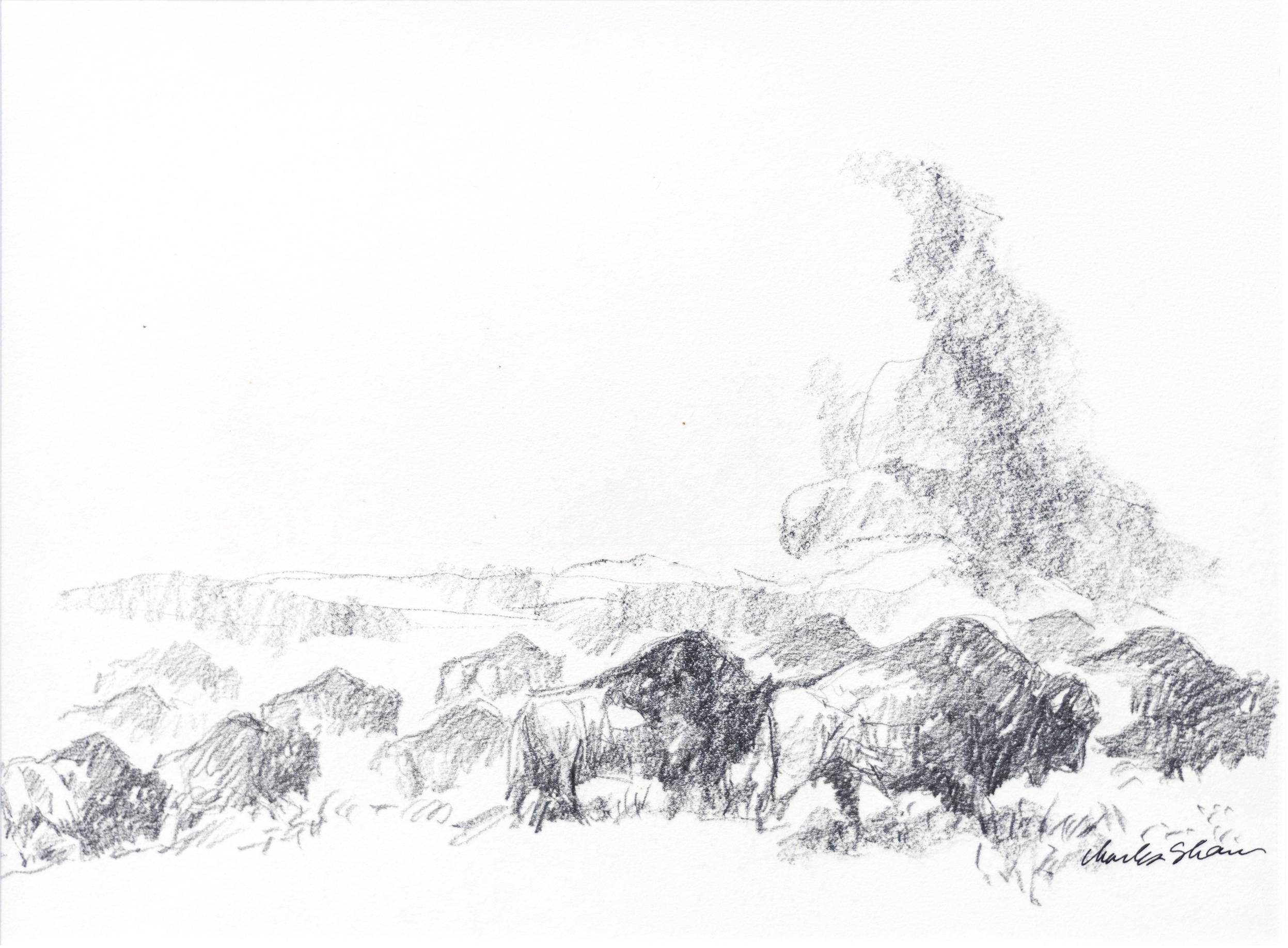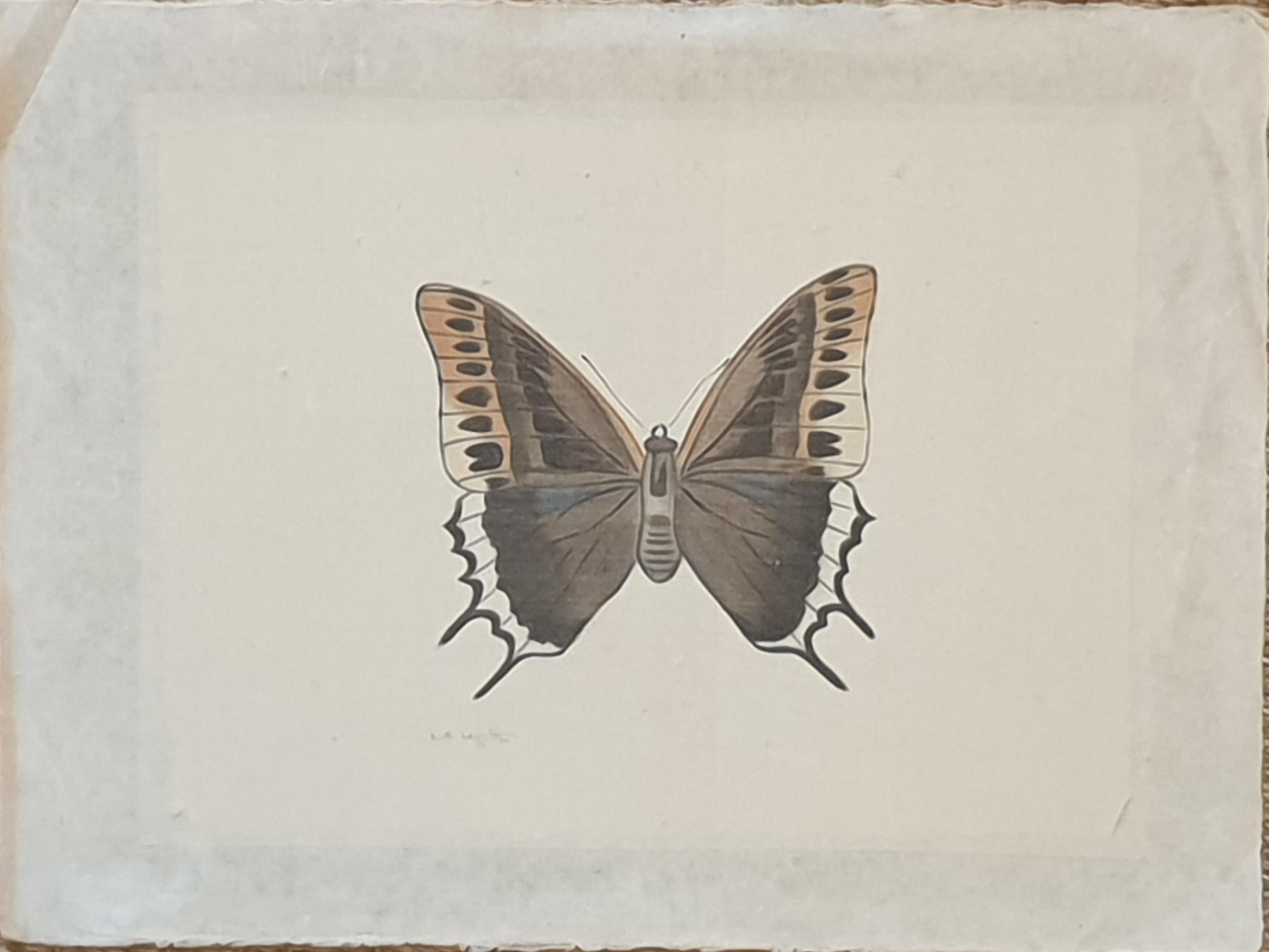Items Similar to Double-sided Horse Studies by Théodore Géricault
Want more images or videos?
Request additional images or videos from the seller
1 of 10
Jean Louis Andre Theodore GericaultDouble-sided Horse Studies by Théodore Géricault1820-1821
1820-1821
About the Item
Recto: two horses, preparatory study for the lithograph "Les Boueux" ("The Muddy Ones")
Verso: four studies of horse heads (including two preparatory studies for the watercolor "Plowing in England"), a study of a life guard with the rump of his horse (preparatory to the lithograph "A Party of Life Guards") and a dog.
In these studies, probably executed during his stays in England in 1820-1821, Géricault reveals his fascination for horses. His pencil stroke is masterful, nervous and unrepentant. Two of them were later used in lithographic compositions published between 1821 and 1823, providing us with an insight into the artist's creative process.
While the most accomplished study for Les Boueux can be considered the recto of the sheet, the juxtaposition of the various studies on the verso, arranged around the ghostly figure of a life guard, creates a highly pleasing dynamic.
1. Théodore Géricault or the fiery life of a Romantic artist
Théodore Géricault was born in Rouen in 1791 into a wealthy family from the Manche region. His father, a magistrate and wealthy landowner, ran a tobacco factory. The family moved to Paris around 1796, and in 1810 Théodore Géricault entered Carle Vernet's studio, where he met his son Horace. He then studied with Pierre-Narcisse Guérin before enrolling on February 5, 1811 at the École des Beaux-Arts in Paris, where he pursued a classical training based on copying the masters at the Louvre Museum.
Géricault was expelled from the École des Beaux-Arts in 1812 for his misconduct; he then rented a back store on rue de la Michodière, where he painted one of his first masterpieces, a portrait of an officer of the imperial guard (the Lieutenant Dieudonné) charging while on horseback. This painting was exhibited at the 1812 Salon and won him the gold medal at the age of 21! Géricault became a sought-after painter, specializing in military subjects.
Géricault falled in love with his aunt Alexandrine Caruel de Saint-Martin (the wife of his mother's brother). Aged 28 years younger than her husband, she was only 6 years older than him. From this affair, which lasted for many years, a son Georges-Hippolyte was born in 1818.
After a short engagement in King Louis XVIII's Company of Grey Musketeers, Géricault, disappointed at not winning the Prix de Rome, spent two years in Italy. On his return in 1817, he embarked on the creation of his masterpiece, The Raft of the Medusa, which was exhibited in the Louvre in 1819 and was negatively received by the critics.
The presentation of the Raft in London in 1820 brought Géricault to the English capital, first for a two-month period between April and June 1820, then again in 1821 after a return to the continent and a stay in Brussels. The painting was triumphantly received in England (partly for the opposite political reasons to those that had led to its unsuccessful reception in France), and 50,000 visitors flocked to Bullock's gallery where it was exhibited during six months.
In November 1821, Géricault returned home very weakened by a venereal disease contracted probably during his stay in England. He fell off his horse several times, and in August 1823 broke his back in a fall. He died at the age of thirty-two on January 24, 1824, after a long agony.
2. Géricault's stays in England, a key stage in his career
Géricault's stays in England, where he was acclaimed by the press and received by the London Society, enabled him to discover both the work of the English landscape painters (Constable and Turner in particular) and horse racing, but also to explore the theme of horses in greater depth through his depiction of street scenes from London life.
In his book Les Chevaux de Géricault (Géricault's Horses), Bruno Chénique analyzes these representations of horses, which, in his view, go far beyond the simple representation of animals and constitute a strange psycho-physionomy of the artist: "the soul of a man, his instincts, his gentleness, his violence, his sexual and mortifying impulses".
3. Drawing description
While Géricault's graphic output is abundant, preparatory graphic elements for Géricault's prints published following his stay in England are quite rare.
The two horses depicted on the recto were later used in the lithograph "Les Boueux" (The Muddy Ones) published by Mrs Hulin in 1823 (in the Quatre sujets divers portfolio; seventh photo in the gallery). The sacks of oats covering the horses' heads have been removed in the final composition.
The various studies on the verso are organized around the ghostly silhouette (barely sketched in pencil) of a life guard shown on foot, next to his horse, whose rump has been studied in detail. This figure is faithfully reproduced in A Party of Life Guards (eigth photo in the gallery), one of the thirteen prints (including the title page) making up the "English portfolio" entitled Various Subjects Drawn from Life and on stone by J. [sic] Gericault, printed in London in 1821.
It is interesting to note that these studies of English military men are quite rare in Géricault's work: Germain Bazin's catalogue raisonné lists only three other ones, two of which are in public collections (at the Louvre and the Paris ENSB).
Two draught horses pulling a plough with a barely sketched wheel appear in the background of our life guard. These two horses are matching those in the background of the watercolour entitled Plowing in England (catalogue raisonné no. 2180, sold at Christie's on 11/15/1985) (last photo in the gallery).
On the top of the verso, we have two expressive horse heads and the quickly sketched silhouette of a dog. All of them evoke other works by Géricault but do not seem to be directly linked to any specific known artwork.
4. Framing
Our drawing is presented in a stuccoed and gilded wood frame from the first quarter of the 19th century. The drawing is included in a double-sided Marie-Louise and can be displayed on both sides.
Main bibliographical references
Germain Bazin, Théodore Géricault : Étude critique, documents et catalogue raisonné, Paris, La Bibliothèque des arts, Wildenstein Institute, Tome VII, 1997
Bruno Chenique, Les chevaux de Géricault, Bibliothèque de l'Image, Paris, 2002
- Creator:Jean Louis Andre Theodore Gericault (1791 - 1824, French)
- Creation Year:1820-1821
- Dimensions:Height: 7.5 in (19.05 cm)Width: 10.07 in (25.58 cm)
- Medium:
- Movement & Style:
- Period:
- Condition:7 ½” x 10 1/16” (19 x 25.5 cm) – Framed 14 3/16” x 16 ½” - (36 x 42 cm) Stuccoed and gilded wood frame with palmettes - First quarter of the 19th century.
- Gallery Location:PARIS, FR
- Reference Number:1stDibs: LU1568213079012
About the Seller
5.0
Vetted Seller
These experienced sellers undergo a comprehensive evaluation by our team of in-house experts.
Established in 2020
1stDibs seller since 2021
8 sales on 1stDibs
Typical response time: 2 hours
- ShippingRetrieving quote...Ships From: PARIS, France
- Return PolicyA return for this item may be initiated within 3 days of delivery.
More From This SellerView All
- A dazzling Venetian Regatta Boat Study attributed to Alessandra MauroLocated in PARIS, FRThis stunning Baroque study depicts a regatta boat, a type of vessel developed in eighteenth-century Venice for the regattas organized by the Serenissima during visits by royalty and...Category
Mid-18th Century Old Masters Figurative Drawings and Watercolors
MaterialsChalk
- Aranea diadima a study by Walter Spies, an artist living in Indonesia in the 30sLocated in PARIS, FRWalter Spies was one of the first Europeans to settle in Bali after a stay in Java. He greatly contributed to the discovery and popularization of Balinese...Category
1920s Art Deco Animal Drawings and Watercolors
MaterialsWatercolor
- Italian Landscape, a drawing by Louis-Jean Desprez (1743 - 1804)Located in PARIS, FRThis landscape, masterfully executed in pen and wash by Louis-Jean Desprez around 1779, probably represents a view of the Roman countryside. The treatment of the trees is very similar to that of two engravings which Desprez executed in Rome, The Island of Cythera and The Temple of Love. 1. Louis-Jean Desprez, a cosmopolitan life between Italy and Sweden Born in Auxerre in 1743, Louis-Jean Desprez probably began his apprenticeship with the engraver Charles-Nicolas Cochin...Category
1770s Old Masters Landscape Drawings and Watercolors
MaterialsCarbon Pencil, Ink
- Three studies executed in the Pitti Palace in 1761 by Jean-Honoré FragonardBy Jean-Honoré FragonardLocated in PARIS, FRThis brilliant study sheet, of which we present here a counterproof, is a souvenir of Fragonard's return journey from Italy. Between April and September 1761, he accompanied the abbot of Saint-Non on his way back to France. Three studies after the masters taken from the Pitti Palace’s gallery in Florence are gathered on this sheet. Although The Ecstasy of Saint Margaret...Category
1760s Old Masters Figurative Drawings and Watercolors
MaterialsCarbon Pencil
- Astraea, a study for the Golden Age fresco at Dampierre by IngresBy Jean-Auguste-Dominique IngresLocated in PARIS, FRThis beautiful drawing, of great technical virtuosity, is one of the many studies made by Ingres for Astraea, one of the key characters in the Golden Age fresco he painted between 18...Category
1840s Old Masters Nude Drawings and Watercolors
MaterialsInk, Pen, Pencil, Carbon Pencil
- The Arab Butcher, a preparatory drawing by Gustave Guillaumet (1840 - 1887)Located in PARIS, FRThis intensely expressive figure is a preparatory study for "Arab Market on the Tocria Plain", a painting exhibited at the 1865 Salon and now in the Musée des Beaux-Arts in Lille. 1...Category
1860s Old Masters Figurative Drawings and Watercolors
MaterialsChalk, Carbon Pencil
You May Also Like
- Fine Early 19th Century Classical Horse StudyLocated in Cirencester, GloucestershireTitle: Portrait of a Horse Artist/ School: French School, circle of Jacques-Laurent Agasse (French 1767-1849) Medium: pencil drawing on paper laid over card Size: 10.25 x 11.5 inc...Category
Early 19th Century Old Masters Animal Drawings and Watercolors
MaterialsPencil
- 18th Century Old Master pencil study of cows by French artist Jean Baptiste HuetLocated in Petworth, West SussexA rare and charming study of cows by 18th Century French painter, engraver and designer Jean-Baptiste Huet. The details are: Jean Baptiste Huet (French, 1745 – 1811) Study of cows P...Category
18th Century Old Masters Animal Drawings and Watercolors
MaterialsPencil
- American Contemporary Art by Michael Alan - Horse RiderBy Michael AlanLocated in Paris, IDFOriginal artwork on paper Michael Alan is an American artist born in 1977 who lives & works in New York, USA. As a multidisciplinary artist. His work has been featured in many solo ...Category
2010s Contemporary Animal Drawings and Watercolors
MaterialsCarbon Pencil, Paper, Ballpoint Pen
- BuffaloLocated in Austin, TXBy Charles William Shaw 7.5" x 10.25" Pencil on PaperCategory
20th Century Animal Drawings and Watercolors
MaterialsArchival Paper, Carbon Pencil
- Galloping rider by Carle Vernet - Drawing on paper 25x30 cmBy Carle Vernet (Antoine Charles Horace Vernet)Located in Geneva, CHCarle VERNET is an artist born in France in 1758 and died in 1836. His works have been sold at public auction 962 times, mainly in the Print-Multiple category. This work is sold with...Category
Early 19th Century Realist Animal Drawings and Watercolors
MaterialsCarbon Pencil
- Study of a Butterfly, Watercolour Silk applied Handmade Paper. La Roche LaffitteBy La Roche LaffitteLocated in Cotignac, FROne from a set of four watercolours of butterflies on silk, applied to handmade paper, with hand cut edges, by French artist La Roche Laffitte. Signed bottom left. (The other 3 items are available separately) A beautifully observed and detailed study of a butterfly painted...Category
Mid-20th Century Realist Animal Drawings and Watercolors
MaterialsSilk, Watercolor, Gouache, Handmade Paper, Carbon Pencil





